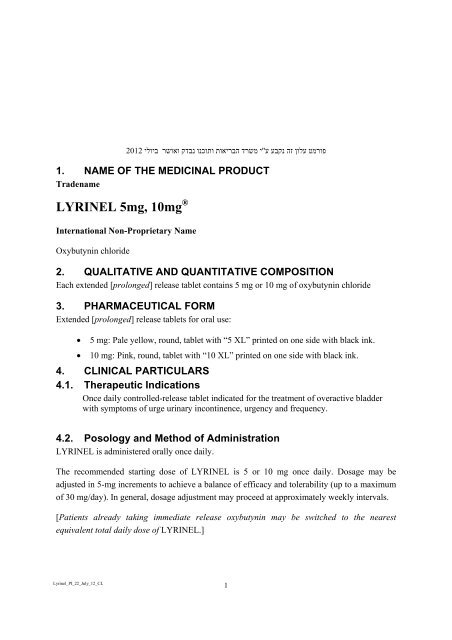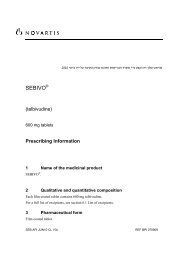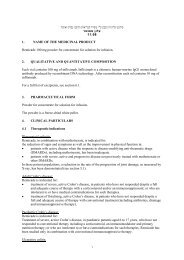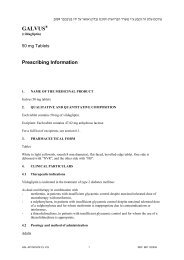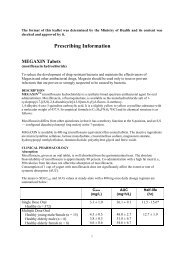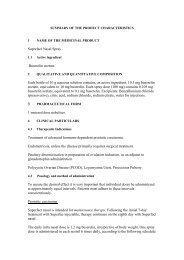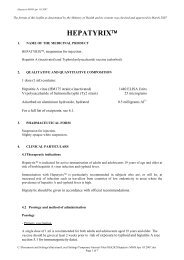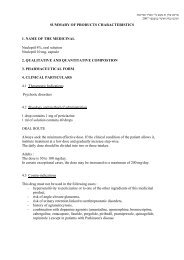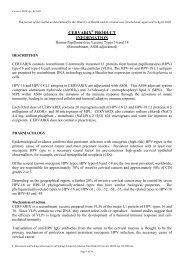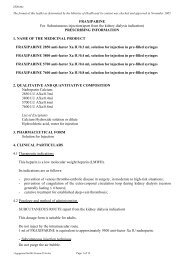LYRINEL 5mg, 10mg
LYRINEL 5mg, 10mg
LYRINEL 5mg, 10mg
Create successful ePaper yourself
Turn your PDF publications into a flip-book with our unique Google optimized e-Paper software.
2012 ילויב<br />
Lyrinel_PI_22_July_12_CL 1<br />
רשואו קדבנ ונכותו תואירבה דרשמ י"<br />
ע עבקנ הז ןולע טמרופ<br />
1. NAME OF THE MEDICINAL PRODUCT<br />
Tradename<br />
<strong>LYRINEL</strong> <strong>5mg</strong>, <strong>10mg</strong> ®<br />
International Non-Proprietary Name<br />
Oxybutynin chloride<br />
2. QUALITATIVE AND QUANTITATIVE COMPOSITION<br />
Each extended [prolonged] release tablet contains 5 mg or 10 mg of oxybutynin chloride<br />
3. PHARMACEUTICAL FORM<br />
Extended [prolonged] release tablets for oral use:<br />
• 5 mg: Pale yellow, round, tablet with “5 XL” printed on one side with black ink.<br />
• 10 mg: Pink, round, tablet with “10 XL” printed on one side with black ink.<br />
4. CLINICAL PARTICULARS<br />
4.1. Therapeutic Indications<br />
Once daily controlled-release tablet indicated for the treatment of overactive bladder<br />
with symptoms of urge urinary incontinence, urgency and frequency.<br />
4.2. Posology and Method of Administration<br />
<strong>LYRINEL</strong> is administered orally once daily.<br />
The recommended starting dose of <strong>LYRINEL</strong> is 5 or 10 mg once daily. Dosage may be<br />
adjusted in 5-mg increments to achieve a balance of efficacy and tolerability (up to a maximum<br />
of 30 mg/day). In general, dosage adjustment may proceed at approximately weekly intervals.<br />
[Patients already taking immediate release oxybutynin may be switched to the nearest<br />
equivalent total daily dose of <strong>LYRINEL</strong>.]
<strong>LYRINEL</strong> must be swallowed whole with the aid of liquids, and must not be chewed, divided,<br />
or crushed.<br />
<strong>LYRINEL</strong> may be administered with or without food (see Section 5.2, Pharmacokinetic<br />
Properties).<br />
Elderly[≥65 years old]:<br />
Same as for adults.<br />
4.3. Contraindications<br />
<strong>LYRINEL</strong> is contraindicated:<br />
• - Hypersensitivity to oxybutynin or any of the excipients<br />
• - Narrow-angle glaucoma or shallow anterior chamber<br />
• - Myasthenia gravis<br />
• - Urinary retention<br />
• - Gastrointestinal obstructive disorder, paralytic ileus or intestinal atony<br />
• - Severe ulcerative colitis<br />
• - Toxic megacolon<br />
• - Urinary frequency and nocturia due to heart or renal failure<br />
• - Porphyria<br />
4.4. Special Warnings and Special Precautions for Use<br />
Oxybutynin is associated with anticholinergic central nervous system (CNS) effects (See<br />
Section 4.8 Undesirable Effects). Patients should be monitored for signs of anticholinergic<br />
CNS effects, particularly in the first few months after beginning treatment or increasing the<br />
dose. If a patient experiences anticholinergic CNS effects, dose reduction or drug<br />
discontinuation should be considered.<br />
Angioedema of the face, lips, tongue and/or larynx has been reported with oxybutynin. In some<br />
cases, angioedema occurred after the first dose. Angioedema associated with upper airway<br />
swelling has the potential to become life-threatening. If involvement of the tongue,<br />
hypopharynx, or larynx occurs, oxybutynin should be promptly discontinued and appropriate<br />
therapy and/or measures necessary to ensure a patent airway should be promptly provided.<br />
Lyrinel_PI_22_July_12_CL 2
Heat prostration (fever and heat stroke due to decreased sweating) can occur when<br />
anticholinergics such as oxybutynin chloride are administered in the presence of high<br />
environmental temperature.<br />
Because anticholinergic agents such as oxybutynin may produce drowsiness (somnolence) or<br />
blurred vision, patients should be advised to exercise caution.<br />
<strong>LYRINEL</strong> should be given with caution in patients with the following conditions:<br />
• hepatic or renal impairment;<br />
• clinically significant bladder outflow obstruction because of the risk of urinary<br />
retention (see Section 4.3, Contraindications);<br />
• gastrointestinal obstructive and gastrointestinal motility disorders because of risk of<br />
gastric retention (see Section 4.3, Contraindications);<br />
• conditions such as ulcerative colitis due to the potential for decreased gastrointestinal<br />
motility;<br />
• myasthenia gravis due to the risk of symptom aggravation;<br />
• gastroesophageal reflux and/or who are concurrently taking drugs (such as<br />
bisphosphonates) that can cause or exacerbate esophagitis;<br />
• preexisting severe gastrointestinal narrowing (pathologic or iatrogenic);<br />
• preexisting dementia treated with cholinesterase inhibitors due to the risk of<br />
aggravation of symptoms.<br />
TRADENAME must be swallowed whole with the aid of liquids, and must not be chewed,<br />
divided, or crushed. The medication is contained within a nonabsorbable shell designed to<br />
release the drug at a controlled rate. The tablet shell is eliminated from the body; patients<br />
should not be concerned if they occasionally notice something that looks like a tablet in their<br />
stool.<br />
Paediatric population<br />
Oxybutynin hydrochloride is not recommended for use in children below age 5 years due to<br />
insufficient data on safety and efficacy.<br />
There is limited evidence supporting the use of Oxybutynin in children with monosymptomatic<br />
nocturnal enuresis (not related to detrusor overactivity).<br />
In children over 5 years of age, Oxybutynin hydrochloride should be used with caution as they<br />
may be more sensitive to the effects of the product, particularly the CNS and psychiatric<br />
adverse reactions.<br />
Lyrinel_PI_22_July_12_CL 3
4.5. Interactions with Other Medicinal Products and Other Forms of<br />
Interaction<br />
The concomitant use of oxybutynin with other anticholinergic medicinal products or drugs<br />
with anticholinergic activity, such as amantadine and other anticholinergic antiparkinsonian<br />
drugs (e.g. biperiden, levodopa), antihistamines, antipsychotics (e.g. phenothiazines,<br />
butyrophenones, clozapine), quinidine, tricyclic antidepressants, atropine and related<br />
compounds like atropinic antispasmodics, dipyridamole, may increase the frequency or<br />
severity of dry mouth, constipation and drowsiness.<br />
Anticholinergic agents may potentially alter the absorption of some concomitantly<br />
administered drugs due to anticholinergic effects on gastrointestinal motility. They may also<br />
antagonize the gastrointestinal prokinetic effects of metoclopramide and domperidone.<br />
However, the interaction between prokinetics and oxybutynin has not been established.<br />
Sublingual nitrates may fail to dissolve under the tongue owing to dry mouth, resulting in<br />
reduced therapeutic effect.<br />
Oxybutynin is metabolised by cytochrome P450 isoenzyme CYP3A4. Mean oxybutynin<br />
chloride concentrations were approximately 2 fold higher when Lyrinel XL was administered<br />
with ketoconazole, a potent CYP3A4 inhibitor. Other inhibitors of cytochrome P450 3A4<br />
enzyme system, such as antimycotic agents (e.g. itraconazole and fluconazole) or macrolide<br />
antibiotics (e.g. erythromycin), may alter oxybutynin pharmacokinetics. The clinical relevance<br />
of such potential interaction is not known. Caution should be used when such drugs are coadministered.<br />
4.6. Pregnancy and Lactation<br />
Reproduction studies with oxybutynin chloride in the mouse, rat, hamster, and rabbit showed<br />
no evidence of impaired fertility or harm to the animal fetus. The safety of <strong>LYRINEL</strong><br />
administered to women who are or who may become pregnant has not been established.<br />
Consequently, risks and potential benefits should be considered before this drug is administered<br />
to pregnant patients.<br />
It is not known whether oxybutynin is excreted in human milk. Caution should be exercised if<br />
<strong>LYRINEL</strong> is administered to a nursing woman.<br />
Lyrinel_PI_22_July_12_CL 4
4.7. Effects on Ability to Drive and Use Machines<br />
No studies have been performed on the effect of <strong>LYRINEL</strong> on the ability to drive and use<br />
machines. Because anticholinergic agents such as oxybutynin may produce drowsiness<br />
(somnolence) or blurred vision, patients should be advised to exercise caution.<br />
4.8. Undesirable Effects<br />
The table below reflects the data obtained with Lyrinel XL in clinical trials and from<br />
postmarketing experience. In clinical trials with Lyrinel XL (n=1006), adverse events were<br />
associated mainly with the anticholinergic actions of oxybutynin. Adverse events were generally<br />
dose related. As with other oxybutynin formulations, dry mouth was the most frequently<br />
reported adverse reaction. However, in clinical studies, dry mouth has been less frequently<br />
reported with Lyrinel XL than with oxybutynin immediate release formulations. For patients<br />
who required final doses of 5 or 10 mg of Lyrinel XL, the relative incidence of dry mouth that<br />
occurred at any dose level was 1.8 times lower compared with patients who required final doses<br />
> 10 mg.<br />
Infections<br />
and<br />
infestations<br />
Blood and<br />
Lymphatic<br />
system<br />
disorders:<br />
Immune<br />
System<br />
Disorders<br />
Metabolism<br />
& Nutrition<br />
Disorders<br />
Very<br />
Commo<br />
n<br />
1/10<br />
Common<br />
1/100 to
Psychiatric<br />
disorders<br />
Nervous<br />
System<br />
Disorders<br />
insomnia,<br />
depression,<br />
nervousness,<br />
confusional state<br />
somnolence,<br />
headache,<br />
dizziness,<br />
dysgeusia<br />
Eye disorders vision blurred,<br />
dry eye,<br />
keratoconjunctiv<br />
itis sicca<br />
Cardiac<br />
disorders<br />
Vascular<br />
disorders<br />
Respiratory,<br />
thoracic and<br />
mediastinal<br />
disorders<br />
Gastrointesti<br />
nal Disorders<br />
dry<br />
mouth<br />
Lyrinel_PI_22_July_12_CL 6<br />
a<br />
anxiety,<br />
abnormal<br />
dreams<br />
paraesthesia,<br />
vertigo<br />
hypertonia,<br />
tremor, tinnitus<br />
conjunctivitis diplopia,<br />
glaucoma,<br />
photophobia<br />
palpitations atrial<br />
arrhythmia,<br />
bradycardia,<br />
bundle branch<br />
block, nodal<br />
arrhythmia,<br />
supraventricula<br />
r extrasystoles<br />
hypertension vasodilatation,<br />
migraine<br />
nasal dryness,<br />
mucosal<br />
dryness, cough,<br />
pharyngolaryngeal<br />
pain,<br />
dry throat<br />
constipation,<br />
diarrhoea,<br />
nausea,<br />
dyspepsia,<br />
abdominal pain,<br />
flatulence,<br />
rhinitis,<br />
hoarseness,<br />
epistaxis,<br />
dyspnoea<br />
dysphagia,<br />
mouth<br />
ulceration,<br />
abdominal<br />
distension,<br />
glossitis,<br />
hypotension,<br />
phlebitis,<br />
ecchymosis<br />
laryngitis,<br />
laryngeal<br />
oedema,<br />
respiratory<br />
disorder,<br />
sputum<br />
increased<br />
faecal<br />
abnormality,<br />
oesophageal<br />
stenosis<br />
acquired,<br />
gastritis,<br />
hallucinations,<br />
night terror,<br />
psychotic<br />
disorder,<br />
agitation,mem<br />
ory<br />
impairment<br />
convulsions<br />
arrhythmia<br />
tachycardia<br />
flushing
Skin and<br />
subcutaneous<br />
tissue<br />
disorders<br />
Musculoskele<br />
tal and<br />
connective<br />
tissue<br />
disorders<br />
Renal and<br />
urinary<br />
disorders<br />
Reproductive<br />
system and<br />
breast<br />
disorders<br />
General<br />
disorders and<br />
administratio<br />
n site<br />
conditions<br />
gastroesophagea<br />
l reflux disease,<br />
loose stools,<br />
vomiting<br />
dry skin, pruritus acne, urticaria,<br />
face oedema,<br />
alopecia,<br />
eczema, nail<br />
disorder, skin<br />
discolouration,<br />
anhidrosis<br />
pain in<br />
extremity, back<br />
pain, arthralgia<br />
micturition<br />
disorder,<br />
residual urine<br />
volume, urinary<br />
retention,<br />
dysuria, urinary<br />
hesitation<br />
asthenia,<br />
oedema<br />
peripheral,<br />
fatigue, chest<br />
pain<br />
Lyrinel_PI_22_July_12_CL 7<br />
stomatitis gastroenteritis<br />
viral, hernia,<br />
rectal disorder,<br />
gastric atony,<br />
tongue<br />
disorder,<br />
tongue oedema<br />
muscle cramps,<br />
myalgia<br />
urinary<br />
frequency,<br />
urinary tract<br />
disorder,<br />
haematuria,<br />
nocturia,<br />
pyuria,<br />
micturition<br />
urgency<br />
breast pain,<br />
vaginitis<br />
pain, thirst,<br />
oedema<br />
hair disorder,<br />
rash maculopapular,<br />
granuloma,<br />
sweating<br />
increased,<br />
photosensitivit<br />
y reaction<br />
arthritis<br />
urinary<br />
incontinence,<br />
urine<br />
abnormal,<br />
urogenital<br />
disorder<br />
vulvovaginal<br />
disorder,<br />
uterine cervical<br />
disorder,<br />
genital<br />
discharge<br />
rigor, pyrexia,<br />
influenza like<br />
illness,<br />
malaise, pelvic<br />
pain<br />
rash<br />
impotence,<br />
erectile<br />
dysfunction
Investigations blood pressure<br />
increased<br />
Injury,<br />
poisoning<br />
and<br />
procedural<br />
complications<br />
Lyrinel_PI_22_July_12_CL 8<br />
electrocardiogr<br />
am abnormal,<br />
blood urea<br />
increased,<br />
blood<br />
creatinine<br />
increased<br />
*Cannot be estimated from the available clinical data.<br />
blood alkaline<br />
phosphatase<br />
increased,<br />
blood lactase<br />
dehydrogenase<br />
increased,<br />
blood<br />
aspartate,<br />
aminotransfera<br />
se increased,<br />
blood alanine<br />
aminotransfera<br />
se increased<br />
Undesirable effects noted with other oxybutynin hydrochloride formulations:<br />
In addition, cyclopegia, mydriasis and suppression of lactation have been reported with the use<br />
of other oxybutynin hydrochloride formulations.<br />
4.9. Overdose<br />
The symptoms of overdose with oxybutynin progress from an intensification of the usual CNS<br />
disturbances (from restlessness and excitement to psychotic behaviour), circulatory changes<br />
(flushing, fall in blood pressure, circulatory failure etc.), respiratory failure, paralysis and<br />
coma.<br />
Measures to be taken are:<br />
1) administration of activated charcoal<br />
2) physostigmine by slow intravenous injection:<br />
Fever should be treated symptomatically with tepid sponging or ice packs.<br />
fall
In pronounced restlessness or excitation, diazepam may be given by intravenous injection.<br />
Tachycardia may be treated with intravenous propranolol and urinary retention managed by<br />
bladder catheterisation.<br />
In the event of progression of curare-like effects to paralysis of the respiratory muscles,<br />
mechanical ventilation will be required.<br />
The continuous release of oxybutynin from Lyrinel XL should be considered in the treatment<br />
of overdose. Patients should be monitored for at least 24 hours.<br />
5. PHARMACOLOGICAL PROPERTIES<br />
5.1. Pharmacodynamic Properties<br />
[Pharmacotherapeutic group: ATC code: G04B D04 Urologicals]<br />
Oxybutynin chloride is a synthetic tertiary amine with direct spasmolytic and anticholinergic<br />
action on the smooth musculature of the detrusor muscle of the bladder. It increases bladder<br />
capacity, reduces the frequency of uninhibited detrusor contractions, and delays the first urge to<br />
urinate. Oxybutynin thus decreases the symptoms of urinary incontinence due to either<br />
idiopathic detrusor instability or detrusor hyperreflexia.<br />
5.2. Pharmacokinetic Properties<br />
Absorption<br />
Following the first dose of <strong>LYRINEL</strong> , oxybutynin plasma concentrations rise for 4 to 6 hours;<br />
thereafter steady concentrations are maintained for up to 24 hours, minimizing fluctuations<br />
between peak and trough concentrations associated with oxybutynin immediate release<br />
formulations.<br />
Lyrinel_PI_22_July_12_CL 9
The relative bioavailabilities of R- and S-oxybutynin from <strong>LYRINEL</strong> are 156% and 187%,<br />
respectively, compared with oxybutynin. The mean pharmacokinetic parameters for R- and Soxybutynin<br />
are summarized in Table [4 or 5]. The plasma concentration-time profiles for Rand<br />
S-oxybutynin are similar in shape.<br />
Table [4 or 5] Mean (SD) R- and S-Oxybutynin Pharmacokinetic Parameters Following a Single Dose of<br />
<strong>LYRINEL</strong> 10 mg (n=43)<br />
Parameters<br />
R-Oxybutynin S-Oxybutynin<br />
(units)<br />
Cmax<br />
(ng/mL)<br />
1.0 (0.6) 1.8 (1.0)<br />
Tmax (h) 12.7 (5.4) 11.8 (5.3)<br />
t ½ (h) 13.2 (6.2) 12.4 (6.1)<br />
AUC(0-48)<br />
(ng•h/mL)<br />
AUCinf<br />
(ng•h/mL)<br />
18.4 (10.3) 34.2 (16.9)<br />
21.3 (12.2) 39.5 (21.2)<br />
Steady-state oxybutynin plasma concentrations are achieved by Day 3 of repeated<br />
TRADENAME dosing, with no observed drug accumulation or change in oxybutynin and<br />
desethyloxybutynin pharmacokinetic parameters.<br />
<strong>LYRINEL</strong> steady-state pharmacokinetics was studied in 19 children aged 5-15 years with<br />
detrusor overactivity associated with a neurological condition (e.g., spina bifida). The<br />
children were on <strong>LYRINEL</strong> total daily dose ranging from 5 to 20 mg (0.10 to 0.77 mg/kg).<br />
Sparse sampling technique was used to obtain serum samples. When all available data are<br />
normalized to an equivalent of 5 mg per day <strong>LYRINEL</strong>, the mean pharmacokinetic<br />
parameters derived for R- and S-oxybutynin and R- and S-desethyloxybutynin are summarized<br />
in Table [5 or 6]. The plasma-time concentration profiles for R- and S-oxybutynin are similar<br />
in shape; Figure 1 shows the profile for R-oxybutynin when all available data are normalized<br />
to an equivalent of 5 mg per day.<br />
Table [5 or 6] Mean ± SD R- and S-Oxybutynin and R- and S-Desethyloxybutynin Pharmacokinetic<br />
Parameters in Children Aged 5-15 Following Administration of 5 to 20mg <strong>LYRINEL</strong> Once Daily<br />
(N=19) All Available Data Normalized To An Equivalent of <strong>LYRINEL</strong> 5 mg Once Daily<br />
R-Oxybutynin S-Oxybutynin R-Desethyl-oxybutynin S-Desethyl-oxybutynin<br />
Cmax<br />
(ng/mL)<br />
0.7 ± 0.4 1.3 ± 0.8 7.8 ± 3.7 4.2 ± 2.3<br />
Tmax (hr) 5.0 5.0 5.0 5.0<br />
AUC<br />
12.8 ± 7.0<br />
(ng.hr/mL)<br />
23.7 ± 14.4 125.1 ± 66.7 73.6 ± 47.7<br />
Figure 1 Mean steady state (±SD) R-oxybutynin plasma concentrations following administration of 5 to 20 mg<br />
<strong>LYRINEL</strong> once daily in children aged 5-15. All available data normalized to an equivalent of<br />
<strong>LYRINEL</strong> 5 mg once daily<br />
Lyrinel_PI_22_July_12_CL 10
Based on two separate pharmacokinetic studies that evaluated the concomitant use of<br />
<strong>LYRINEL</strong> with an antacid and with a proton pump inhibitor, drugs that increase gastric pH do<br />
not affect the release of drug from the tablet or resulting plasma concentrations of oxybutynin<br />
and its metabolite, desethyloxybutynin.<br />
Dose Proportionality<br />
Pharmacokinetic parameters of oxybutynin and desethyloxybutynin (Cmax and AUC) following<br />
administration of 5-20 mg of <strong>LYRINEL</strong> are dose proportional.<br />
Distribution<br />
Oxybutynin is widely distributed in body tissues following systemic absorption. The volume of<br />
distribution is 193 L after intravenous administration of 5 mg oxybutynin chloride . Both<br />
enantiomers of oxybutynin are highly bound (>99%) to plasma proteins. Both enantiomers of<br />
desethyloxybutynin are also highly bound (>97%) to plasma proteins. The major binding<br />
protein is alpha-1 acid glycoprotein.<br />
Metabolism and Excretion<br />
Oxybutynin is metabolized primarily by the cytochrome P450 enzyme systems, particularly<br />
CYP3A4 found mostly in the liver and gut wall. Its metabolic products include<br />
phenylcyclohexylglycolic acid, which is pharmacologically inactive, and desethyloxybutynin,<br />
which is pharmacologically active. Following <strong>LYRINEL</strong> administration, plasma concentrations<br />
Lyrinel_PI_22_July_12_CL 11
of R- and S-desethyloxybutynin are 73% and 92%, respectively, of concentrations observed<br />
with oxybutynin.<br />
Oxybutynin is extensively metabolized by the liver, with less than 0.1% of the administered<br />
dose excreted unchanged in the urine. Also, less than 0.1% of the administered dose is excreted<br />
as the metabolite desethyloxybutynin.<br />
Food Effects<br />
The rate and extent of absorption and metabolism of oxybutynin are similar under fed and<br />
fasted conditions.<br />
Special Populations<br />
Gender: There are no significant differences in the pharmacokinetics of oxybutynin in healthy<br />
male and female volunteers following administration of <strong>LYRINEL</strong>.<br />
Geriatric: The pharmacokinetics of <strong>LYRINEL</strong> were similar in all patients studied (up to 78<br />
years of age).<br />
Race: Available data suggest that there are no significant differences in the pharmacokinetics<br />
of oxybutynin based on race in healthy volunteers following administration of <strong>LYRINEL</strong>.<br />
Renal Insufficiency: There is no experience with the use of <strong>LYRINEL</strong> in patients with renal<br />
insufficiency.<br />
Hepatic Insufficiency: There is no experience with the use of <strong>LYRINEL</strong> in patients with<br />
hepatic insufficiency.<br />
5.3. Preclinical Safety Data<br />
A 24-month study in rats at dosages of oxybutynin chloride of 20, 80 and 160 mg/kg/day<br />
showed no evidence of carcinogenicity. These doses are approximately 6, 25 and 50 times the<br />
maximum human exposure, based on surface area.<br />
Oxybutynin chloride showed no mutagenic activity when tested in Schizosaccharomyces<br />
pompholiciformis, Saccharomyces cerevisiae, and Salmonella typhimurium test systems.<br />
Reproduction studies with oxybutynin chloride in the mouse, rat, hamster, and rabbit showed<br />
no evidence of impaired fertility.<br />
Lyrinel_PI_22_July_12_CL 12
6. PHARMACEUTICAL PARTICULARS<br />
6.1. List of Excipients<br />
<strong>LYRINEL</strong> also contains the following inert ingredients: cellulose acetate, hypromellose, ,<br />
magnesium stearate, polyethylene glycol, polyethylene oxide 200K, polyethylene oxide 2000K,<br />
Black iron oxide : lactose 95:5<br />
5 mg: iron oxide green:lactose 95:5, opadry YS-1-12871-A light yellow<br />
10 mg: red ferric oxide, opadry pink YS-1-14518-A<br />
6.2. Incompatibilities<br />
None known.<br />
6.3. Special Precautions for Storage<br />
Do not store above 25°C . Keep container tightly closed. Keep out of the reach of children.<br />
6.4 Nature and contents of containers<br />
High density polyethylene bottles with child resistant closure (polypropylene) and<br />
desiccant.<br />
Pack sizes 30 tablets<br />
7. MARKETING AUTHORISATION HOLDER<br />
J-C Health Care Ltd. Kibbutz Shefayim 60990<br />
8. Manufacturer<br />
Janssen Cilag SpA, Latina, Italy<br />
Lyrinel_PI_22_July_12_CL 13


